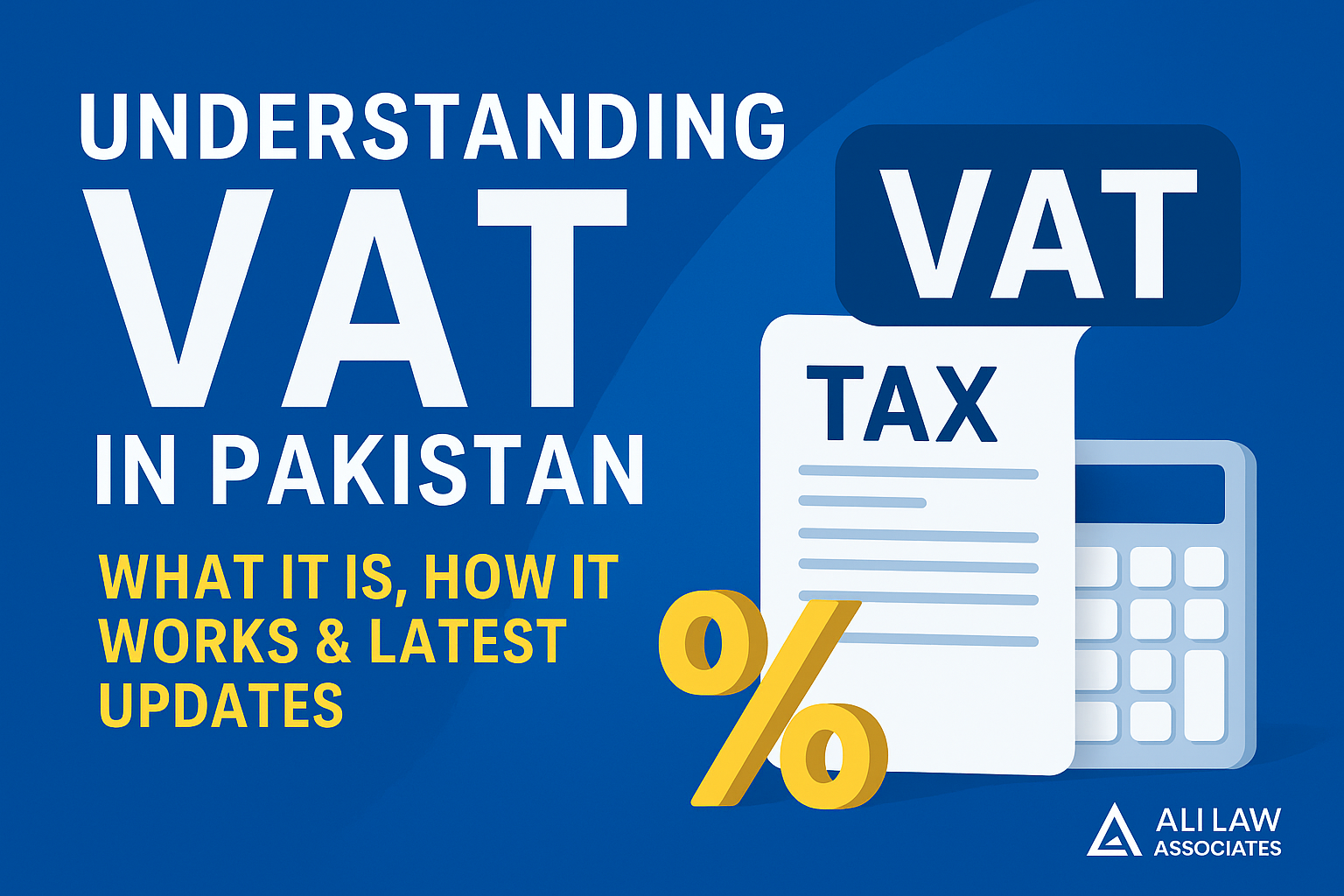What It Is, How It Works & Latest Updates
VAT in Pakistan or Value Added Tax (VAT), known in Pakistan as sales tax, is one of the most significant revenue sources for the government. Whether you run a manufacturing unit, a retail shop, or a service-based business, understanding VAT is crucial for staying compliant, avoiding penalties, and running your operations smoothly.
In this detailed guide, we’ll break down what VAT is, how it works in Pakistan, the different VAT types, and recent 2025 updates that every business owner needs to know.
1. What Is VAT (Sales Tax) in Pakistan?
VAT is an indirect tax charged on the value added to goods and services at every stage of production and distribution. Unlike income tax, which is directly deducted from earnings, VAT is collected by businesses from consumers on behalf of the government.
In Pakistan, VAT is implemented in the form of Sales Tax under the Sales Tax Act, 1990. It applies to:
- Most manufactured goods
- Certain imported goods
- Specific services (rates vary by province)
Key point: While VAT is collected at each step, the final burden falls on the end consumer, ensuring that businesses only pay tax on the value they themselves add.
Learn more: Wikipedia – Value Added Tax
2. How VAT Works in Pakistan – Step-by-Step
To understand VAT, let’s go through a simplified example:
Example:
- Manufacturer buys raw materials worth Rs. 100 and pays Rs. 18 as VAT (18% rate).
- They process the materials into finished goods, adding value, and sell them to a wholesaler for Rs. 200 plus Rs. 36 VAT.
- The manufacturer deducts the input VAT (Rs. 18) from the output VAT (Rs. 36) and pays only Rs. 18 to the FBR.
- The wholesaler sells to a retailer for Rs. 250 plus Rs. 45 VAT, again deducting their input VAT before paying the net tax.
This system prevents cascading tax—where tax would be charged on top of tax—and promotes fair pricing.
Reference: FBR – Sales Tax Guide
3. VAT Rates in Pakistan
VAT (sales tax) rates vary depending on the type of goods or services:
Goods – Federal Jurisdiction
- Standard rate: 18% on most goods.
- Zero-rated: Exports are taxed at 0% to boost competitiveness in foreign markets.
- Reduced rates: Between 1% and 16% for selected goods like fertilizers, gold, and certain machinery.
- Additional rate: 3% on sales to unregistered buyers.
More details: PwC – Pakistan Tax Summary
Services – Provincial Jurisdiction
VAT on services is collected at the provincial level under separate revenue authorities:
- Sindh Revenue Board (SRB): ~15%
- Punjab Revenue Authority (PRA): ~16%
- Khyber Pakhtunkhwa Revenue Authority (KPRA): ~15%
- Balochistan Revenue Authority (BRA): ~15%
Visit: Sindh Revenue Board
4. Types of VAT in Pakistan
Although VAT in Pakistan is unified under sales tax laws, it can be categorized as follows:
- Standard Rated VAT – The default rate (18%) applied to most goods and services.
- Zero Rated VAT – Applies to exports and certain essential goods; businesses can claim input tax credits.
- Exempt VAT – Certain sectors like basic food items and medicines are exempt from VAT.
- Reduced Rate VAT – A lower rate for targeted goods to support specific industries.
Learn more: Taxation PK – VAT Types
5. Why VAT Matters for Businesses and Consumers
Benefits for Businesses:
- Encourages proper record-keeping and transparency.
- Allows recovery of input tax, reducing net tax costs.
- Builds credibility for bidding on government contracts and tenders.
Benefits for the Government:
- Stable source of revenue.
- Reduces reliance on direct taxes.
- Enhances tax compliance through digital integration.
Consumer Impact:
- Increases the final price of goods/services.
- Exemptions on essential items protect low-income households.
6. Recent VAT Updates in Pakistan (2025)
With digital transformation in taxation, Pakistan has introduced several major changes to VAT compliance:
a) Mandatory E-Invoicing & POS Integration
From early 2025, the Federal Board of Revenue (FBR) requires major taxpayers to:
- Integrate accounting and POS systems with FBR servers.
- Issue invoices with QR codes.
- Submit transaction data in JSON format for real-time reporting.
Source: TPA Global – Pakistan E-Invoicing Mandate
b) SRO 69(I)/2025 – New Compliance Rules
Issued on 29 January 2025, this SRO consolidated e-invoicing regulations into Chapter XIV of the Sales Tax Rules, 2006, with stricter obligations for:
- Secure data handling.
- Digital signatures on invoices.
- Daily VAT fiscal register submissions.
Reference: EY Global Tax News
c) Deadline Extensions for Compliance
- Corporate taxpayers: Until 1 July 2025.
- Non-corporate taxpayers: Until 1 August 2025.
Read more: VATCalc – Pakistan VAT Updates
7. Common VAT Challenges for Businesses in Pakistan
While VAT improves transparency, businesses often face these hurdles:
- Delays in VAT refund processing.
- Complex provincial vs. federal jurisdiction issues.
- Frequent changes in VAT rates and rules.
- Initial cost of POS/e-invoicing integration.
Guidance: FBR – E-Invoicing FAQ
8. Best Practices for VAT Compliance
To ensure smooth VAT operations, businesses should:
- Maintain accurate sales and purchase records.
- File returns before the due date.
- Stay updated with FBR SROs and notifications.
- Train staff on e-invoicing and VAT record management.
- Consult a tax expert for complex transactions.
Conclusion – VAT Compliance Is a Growth Tool, Not Just a Legal Obligation
VAT in Pakistan is more than just a tax; it’s a system designed to ensure fair taxation at every step of production and distribution. With 2025’s e-invoicing mandate, compliance is now both a legal requirement and a strategic move for business growth.
Need expert help with VAT registration, e-invoicing setup, or compliance? Contact Ali Law Associates today for professional legal and tax advisory services.


